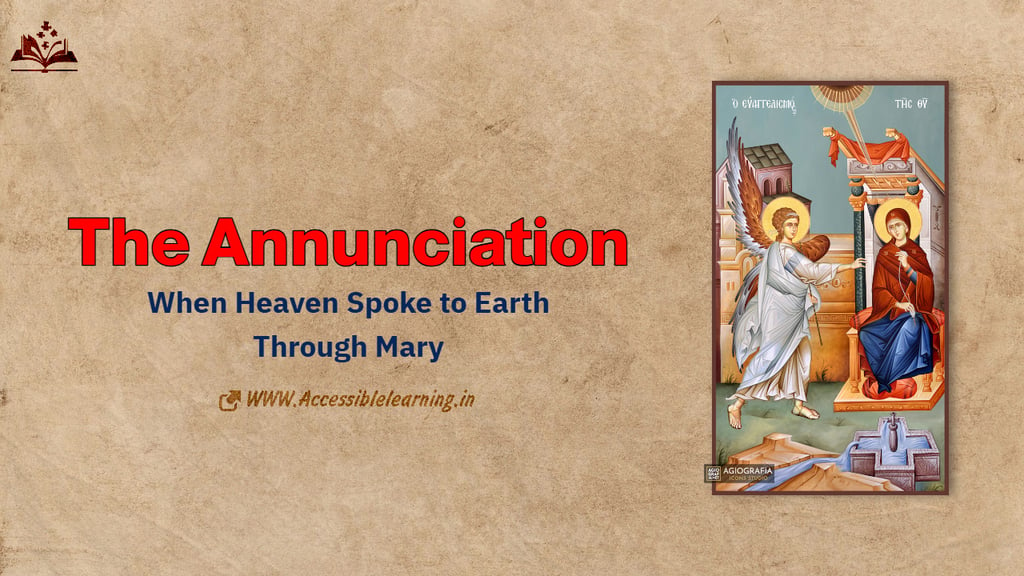
Annunciation of the Theotokos: A Divine Encounter That Changed History
Discover the profound significance of the Annunciation of the Theotokos, a pivotal event in Christian history. Learn about its biblical account, theological importance, global traditions, artistic representations, and impact on Christian devotion. Explore how this divine moment continues to inspire faith and spirituality across the world.
EUROPEAN UNIONCULTURE/TRADITIONEVENT/SPECIALCELEBRATION/FESTIVALS
Kim Shin
4/4/20253 min read


The Annunciation of the Theotokos is one of the most profound events in Christian history, celebrated by millions worldwide. It marks the moment when the Archangel Gabriel appeared to the Virgin Mary, announcing that she would conceive Jesus Christ, the Son of God. This sacred event, observed on March 25th, is a cornerstone of Christian theology, representing faith, obedience, and divine intervention in human history.
The Biblical Account
The Annunciation is described in the Gospel of Luke (1:26-38). According to the passage, Gabriel was sent by God to the town of Nazareth, where Mary, a young virgin betrothed to Joseph, received the divine message.
Gabriel greeted Mary with the words, “Hail, full of grace, the Lord is with you.” This greeting confused and humbled Mary. Gabriel then revealed that she had been chosen to conceive and bear Jesus Christ, explaining that He would be called the Son of the Most High and that His Kingdom would have no end.
Mary, though initially troubled, responded with faith and humility, saying, “Behold the handmaid of the Lord; be it unto me according to thy word.” This act of submission to God's will is regarded as a pivotal moment in salvation history, showcasing Mary's unwavering faith.
Theological Significance
The Annunciation is deeply intertwined with the concept of Incarnation, where God became human through Jesus Christ. This event signifies:
God’s Plan for Salvation: The announcement to Mary was a fulfillment of prophecies, including Isaiah 7:14, which foretold a virgin bearing a son named Immanuel.
Mary’s Role as Theotokos (God-Bearer): This title, affirmed by the Council of Ephesus in 431 AD, emphasizes Mary’s unique role in carrying and giving birth to Christ.
The Power of Free Will: Unlike other divine interventions, Mary's consent was crucial, highlighting human participation in God’s redemptive plan.
Foreshadowing of Christ’s Mission: The Annunciation set the stage for Christ’s ultimate sacrifice, establishing His role as the Savior of mankind.
The Holy Spirit’s Role: Gabriel explained that the conception of Jesus would be through the power of the Holy Spirit, affirming His divine nature.


How the Annunciation is Celebrated
The Feast of the Annunciation is one of the Great Feasts in the Orthodox and Catholic Churches. The day is commemorated with special church services, prayers, hymns, and fasting exceptions (especially when it falls during Lent). In the Greek Orthodox tradition, this feast is also associated with Greek Independence Day, symbolizing the connection between faith and national identity.
Customs and Traditions Across the World
Greece: Churches hold special liturgies, and many Greeks celebrate their national independence, which coincides with the feast.
Italy and Spain: Parades and processions take place, often accompanied by hymns and prayers dedicated to Mary.
Ethiopia: The feast is part of a larger devotion to the Virgin Mary, with extended fasting and community gatherings.
Russia and Eastern Europe: Orthodox Christians observe the day with icon veneration and special prayers, reflecting on Mary’s pivotal role in Christian history.
Iconography and Artistic Representations
Throughout history, the Annunciation has been a popular subject in Christian art, depicted in churches, manuscripts, and paintings. Common elements in these artworks include:
The Archangel Gabriel approaches Mary with a scroll or a staff.
Mary was seated or standing with a humble expression, sometimes reading scriptures.
The presence of the Holy Spirit, often represented as a dove.
Artists like Leonardo da Vinci, Fra Angelico, and Sandro Botticelli have immortalized this sacred moment in their masterpieces.
Annunciation in Other Traditions
While predominantly a Christian celebration, variations of the Annunciation exist in Islam, where Mary (Maryam) is revered as one of the most pious women. The Quran (Surah Maryam 19:16-21) narrates a similar account of Gabriel announcing the miraculous birth of Isa (Jesus) to Maryam.
Impact on Christian Devotion
The Annunciation has inspired numerous prayers, hymns, and devotions, including:
The Angelus: A traditional Catholic prayer recited daily to commemorate the Annunciation.
The Akathist Hymn: A Byzantine hymn dedicated to the Theotokos, sung during the Great Lent.
The Rosary: The Annunciation is the first Joyful Mystery, meditated upon in the Rosary prayer.
Scientific and Historical Perspectives
The Annunciation has also been a subject of historical and theological studies, with scholars examining
The cultural context of 1st-century Judea, where women had limited autonomy, made Mary’s acceptance of Gabriel’s message even more remarkable.
Linguistic studies on the term “Theotokos,” which played a crucial role in shaping early Christian debates on the nature of Christ.
Archaeological discoveries in Nazareth support the existence of settlements during Mary’s time.
The Annunciation of the Theotokos is more than just a religious event—it is a powerful reminder of faith, obedience, and divine love. Mary's acceptance of God’s will set the stage for the greatest act of redemption. As believers reflect on this moment, they find inspiration in her unwavering trust, a testament to the profound relationship between humanity and the divine.
Whether through prayer, artistic appreciation, or theological study, the Annunciation continues to be a source of hope and spiritual renewal across the world.
Subscribe To Our Newsletter
All © Copyright reserved by Accessible-Learning Hub
| Terms & Conditions
Knowledge is power. Learn with Us. 📚


